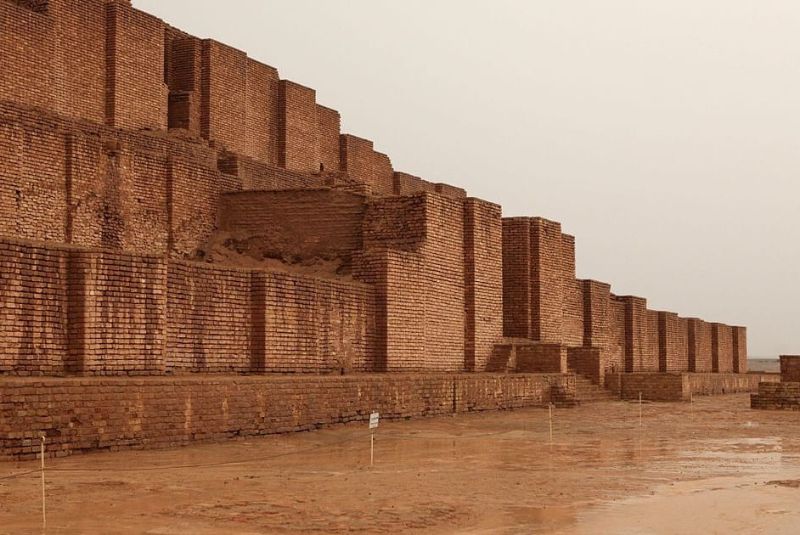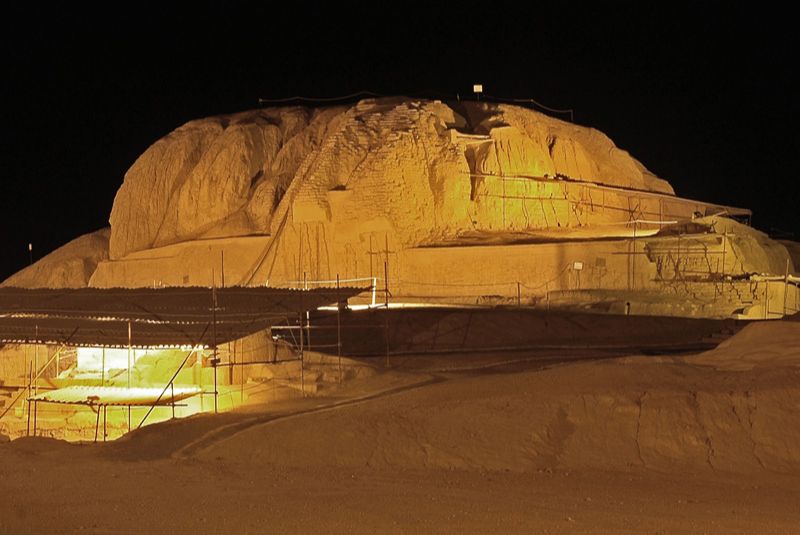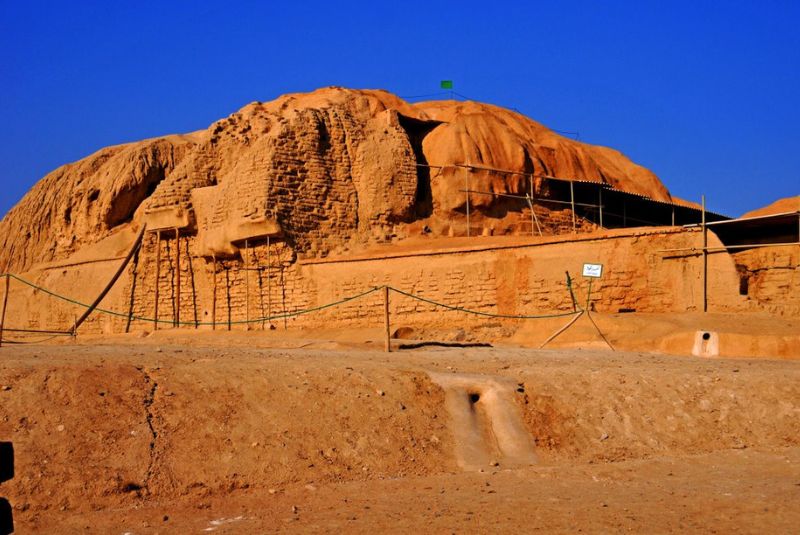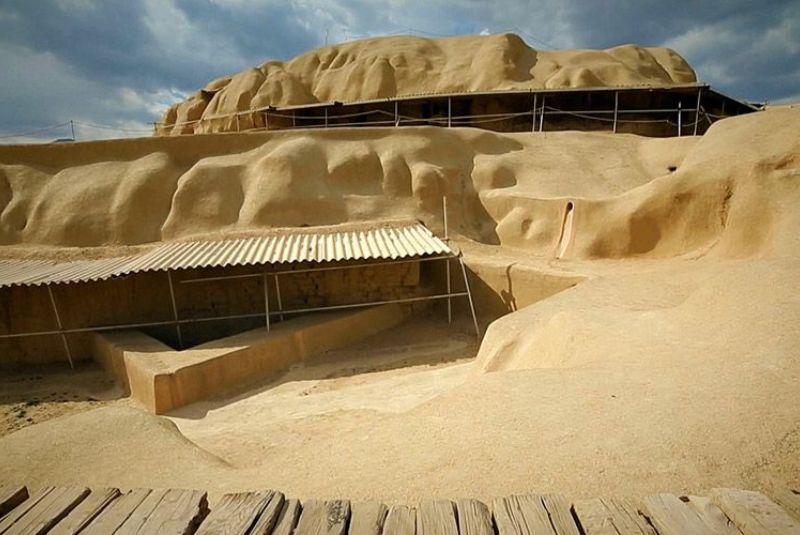Iran's Ziggurats: Unveiling the Secrets of the Past
The term "ziggurat" is derived from the Babylonian word "ziqqurratu," which translates to "mountain peak" or "pinnacle."
In ancient times, mountains were viewed as a connection between the celestial and earthly realms. For example, the Greek pantheon was believed to reside on Mount Olympus, emphasizing the association between mountains and divine presence.
Iran, renowned for its rich cultural heritage, made notable contributions to ziggurat architecture. The country's unique architectural techniques and cultural influences shaped the design and construction of Iran’s ziggurats.
This article focuses on the three prominent ziggurats in Iran: Tchogha Zanbil, Haft Tappeh, and Sialk Site. It explores their historical context, architectural features, religious significance, and their significance in understanding ancient Iranian civilization.
Iran's Ziggurats
- Tchogha Zanbil
- Haft Tappeh
- Sialk Site
Tchogha Zanbil

Tchogha Zanbil, one of the extraordinary Iran ziggurats, is an ancient architectural marvel located in the Khuzestan province of southwestern Iran. Constructed during the Elamite civilization around 1250 BC under the reign of King Untash-Napirisha, it stands as a testament to the rich history of the region. The name "Tchogha Zanbil," meaning "basket mound" in Persian, derives from the ziggurat's distinctive shape resembling a basket.
Situated near the influential city of Susa, Tchogha Zanbil held significant religious significance as a dedicated center for worshiping the Elamite deities, most notably the god Inshushinak. It served as a focal point for religious and cultural activities, playing an integral role in the spiritual and communal life of the Elamite people.
Tchogha Zanbil was originally intended to be the centerpiece of King Untash-Napirisha's ambitious project to establish a new capital city known as Dur-Untash. However, due to political unrest and subsequent invasions, the city was never fully realized, leaving the grand ziggurat as a remarkable testament to the aspirations and architectural prowess of the Elamite civilization.
| Read the complete article: Choqa Zanbil Ziggurat | An Ancient Wonder of the World
Architectural Features and Unique Characteristics
Tchogha Zanbil is an enormous structure, originally standing at approximately 105 feet (32 meters) in height. It consists of five concentric square platforms, decreasing in size as they ascend. The outermost platform measures around 457 feet (139 meters) on each side.
The ziggurat was constructed using mud bricks, a common building material of the time. The bricks were baked in kilns and then assembled with bitumen as mortar.
At the top of the ziggurat, there were temples dedicated to different deities. These temples housed statues and offered spaces for religious rituals. Surrounding the ziggurat, there were several altars where offerings and sacrifices were made.

Notable Discoveries or Artifacts Found at the Site
Excavations at Tchogha Zanbil have revealed fascinating insights into the Elamite civilization. Notable discoveries include:
Tablets: A significant number of clay tablets were found at the site, inscribed with cuneiform script. These tablets provided valuable information about the Elamite language, administration, and religious practices.
Artifacts: Various artifacts, such as jewelry, pottery, and statues, have been unearthed at Tchogha Zanbil. These objects shed light on the artistic and cultural achievements of the Elamites.
Water Management System: The excavations uncovered an intricate water management system at Tchogha Zanbil, including canals, dams, and water storage facilities. This indicates the advanced engineering skills of the Elamites.
| Discover: Isfahan's Khaju Bridge
Haft Tappeh
Haft Tappeh, another remarkable Iran ziggurat, is an archaeological site located in southwestern Iran, specifically in the Khuzestan Province. It dates back to around 1375 BC and holds significant historical and cultural importance as it is associated with the ancient Elamite civilization. Haft Tappeh served as a prominent cultural and political hub during its time, providing valuable insights into the rich history of ancient Iran.
The ziggurat at Haft Tappeh, situated within the expansive Haft Tappeh archaeological complex, stands proudly on a raised platform, commanding the surrounding landscape. As one of the revered Iran ziggurats, it functioned as a central religious and ceremonial site, believed to be a sacred place of worship dedicated to the Elamite deities. The ziggurat's grandeur and prominence signify its significance in the religious and cultural practices of the Elamite civilization.
| Suggestion: Naqsh-e Rustam | Ancient Treasures & Zoroastrian Legacy

Architectural Characteristics
The Haft Tappeh ziggurat followed the traditional stepped pyramid design common to Mesopotamian ziggurats. It consisted of several terraces or levels, constructed with mud bricks. Each level was progressively smaller than the one below it, leading up to a shrine or temple at the top.
The ziggurat was built using mud bricks that were shaped and baked in kilns. The bricks were then layered and bonded with mortar made from mud and other organic materials. The exterior of the ziggurat may have been adorned with decorative elements such as glazed bricks or stucco.
Within the Haft Teppeh ziggurat complex, there were likely additional structures and features associated with religious rituals and administrative functions. These may have included courtyards, halls, altars, and smaller temples dedicated to various deities.
| Suggestion: The Tallest Pure-Brick Tower on the Planet | Gonbade Kavous
Significance of Haft Tappeh
Haft Teppeh is of great importance for understanding the ancient Iranian civilization, particularly the Elamite culture. The site provides valuable archaeological evidence, including artifacts, inscriptions, and architectural remains, that shed light on the religious, political, and social practices of the time.
Studying Haft Tappeh helps in understanding the religious beliefs and practices of the Elamites, their architectural achievements, and their interaction with neighboring civilizations. It contributes to our knowledge of ancient Iranian history and offers insights into the broader cultural and historical developments of the region.
Sialk Site

The Tappeh Siyalk, also known as the Sialk Site, located in Kashan, Iran, is an archaeological site that dates back approximately 4250-5000 years ago, placing it in the Chalcolithic period (Copper Age) of ancient Iran. This era marked an important transition between the Neolithic Age and the Bronze Age, characterized by advancements in early metalworking and the development of more complex social structures.
As one of the notable Iran ziggurats, the ziggurat at the Sialk Site stands as a significant architectural structure, reflecting the cultural significance of the time. Ziggurats, with their monumental stepped pyramid design, held immense religious and symbolic value as centers of worship and representations of power and authority. The presence of a ziggurat at the Sialk Site suggests the existence of a thriving society with a well-organized religious and social system. It underscores the cultural and architectural achievements of ancient Iran during that period.

Siyalk and its surrounding area are believed to have originated due to the presence of abundant water sources nearby, which continue to flow to this day. The Cheshme-ye Soleimān, commonly known as Solomon's Spring, has been supplying water to the region for thousands of years, originating from the neighboring mountains.
The Fin Garden, which was reconstructed in the 1600s, is now a popular tourist destination. It served as a getaway for Persian kings of the Safavid dynasty, who would spend their leisure time away from their capital cities.
Additionally, the garden houses the mausoleum of Pirūzān (Firūzān), also known as Abu Lu Lu in Islamic and Arab sources. Pirūzān was an Iranian patriot who, in 644 CE, assassinated the second Muslim Caliph Umar ibn al-Khatab as a response to the treatment of Iranians by occupying Muslim forces.
| Read more: Pasargadae | Legacy of Cyrus the Great & Ancient City
Architectural Style and Materials Used
The Sialk Site ziggurat, like other ziggurats of the period, was constructed using mud bricks, which were readily available and commonly used in ancient Mesopotamian and Iranian architecture. The ziggurat likely followed a stepped pyramid design, with multiple terraces or levels that decreased in size as they ascended.

Religious and Social Significance
The Sialk Site ziggurat played a significant role in the religious and social life of the ancient community that built it. Ziggurats were considered sacred structures, serving as a link between the earthly realm and the divine. They were associated with the worship of deities and served as places of religious rituals, offerings, and ceremonies.
The presence of a ziggurat at the Sialk Site suggests a highly organized religious system and the importance of religious beliefs in the society of that time. The ziggurat would have been a focal point for community gatherings and activities, contributing to the cohesion and identity of the society.
Furthermore, ziggurats often represented the power and authority of rulers or elites. The construction of a ziggurat at the Sialk Site indicates the presence of a hierarchical social structure and a centralized authority that oversaw the construction and maintenance of such monumental structures.
| Suggestion: Vank Cathedral | Persian & Armenian Cultural Masterpiece
Bottom Line
Iran’s ziggurats, including Tchogha Zanbil, Haft Tappeh, and the Sialk Site, hold immense historical and cultural significance. These ancient structures provide valuable insights into Iran's ancient history and architectural heritage. As religious, political, and cultural centers, they reflect the beliefs, power structures, and societal systems of their respective civilizations. Preserving and studying these architectural wonders is crucial for understanding ancient Iran and appreciating its cultural heritage. They serve as tangible connections to the past and remind us of the ingenuity and richness of ancient Iranian civilizations.
Share your story!
Comment below and let us know about your Experience.
Your story inspires others!


Comment
Leave a Comment